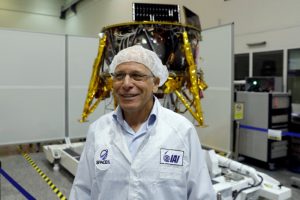
By Ari Rabinovitch
YEHUD, Israel (Reuters) – An Israeli non-profit group plans to land an unmanned spacecraft on the moon in February in the first landing of its kind since 2013.
The craft, which is shaped like a round table with four carbon fiber legs, is set to blast off in December from Florida’s Cape Canaveral aboard a SpaceX Falcon 9 rocket, said Ido Anteby, chief executive of the SpaceIL non-profit.
It aims to transmit pictures and videos back to earth over two days after it lands on Feb. 13 as well as measuring magnetic fields.

Ido Anteby, SpaceIL’s CEO stands in front of an unmanned spacecraft which an Israeli team plans to launch into space at the end of the year and to land it on the Moon next year, in Yahud, Israel, July 10, 2018 REUTERS/Ronen Zvulun
“Our spacecraft will be the smallest ever to land on the moon,” said Anteby.
Since 1966, the United States and the former Soviet Union have put around 12 unmanned spacecraft on the moon using braking power to perform “soft” landings and China did so in 2013.
SpaceIL was founded in 2011 by a group of engineers with a budget of about $90 million and they had to sacrifice size and operational capabilities for more efficient travel.
The craft, unveiled on Tuesday at state-owned defense contractor Israel Aerospace Industries, stands about 1.5 meters high and weighs 585 kg (1,290 lb). The spacecraft has four carbon fiber legs and fuel takes up two-thirds of its weight.
At 60,000 km (37,000 miles) above Earth the spacecraft will deploy. It will orbit Earth in expanding ellipses and, about two months later, cross into the moon’s orbit. It will then slow and carry out a soft landing causing no damage to the craft.
“The landing is the most complicated part. The spot chosen is relatively flat and the spacecraft has eye contact with Earth for communication,” Anteby said. “From the moment the spacecraft reaches the point that it begins the landing, it will handle it totally autonomously.”
SpaceIL is backed mainly by private donors, including U.S. casino magnate Sheldon Adelson and billionaire Morris Kahn who co-founded Amdocs, one of Israel’s biggest high-tech companies.
(Editing by Matthew Mpoke Bigg)
